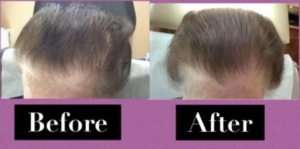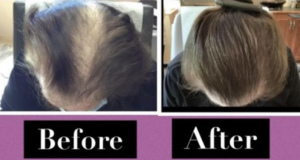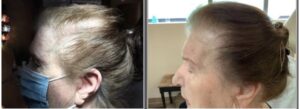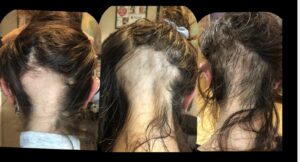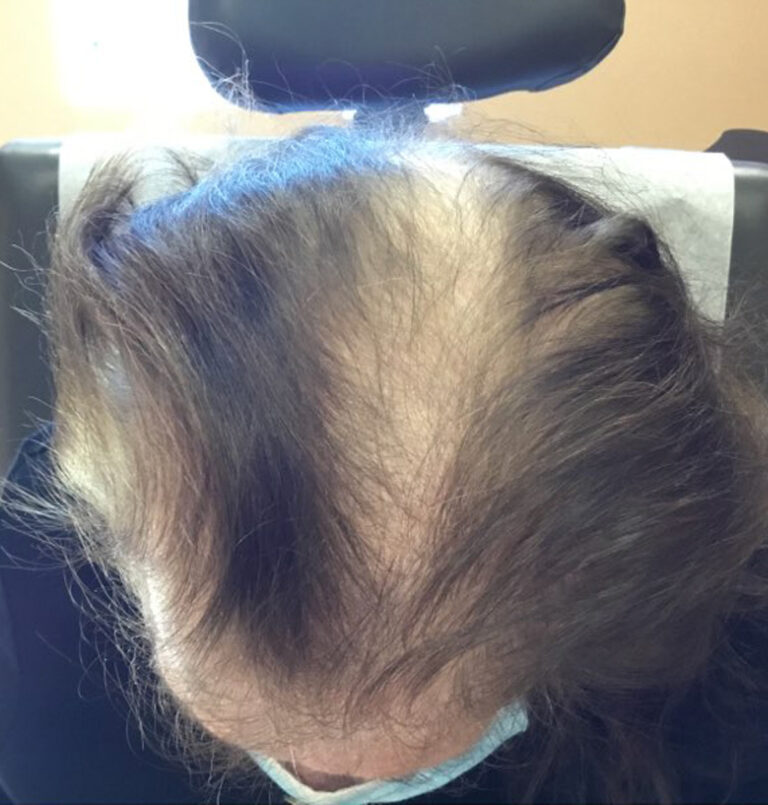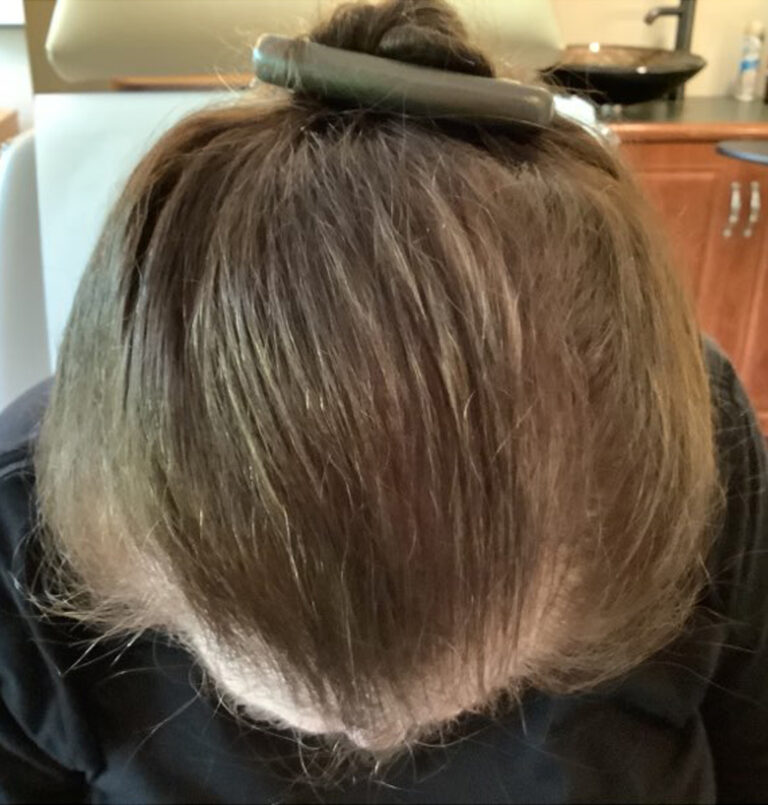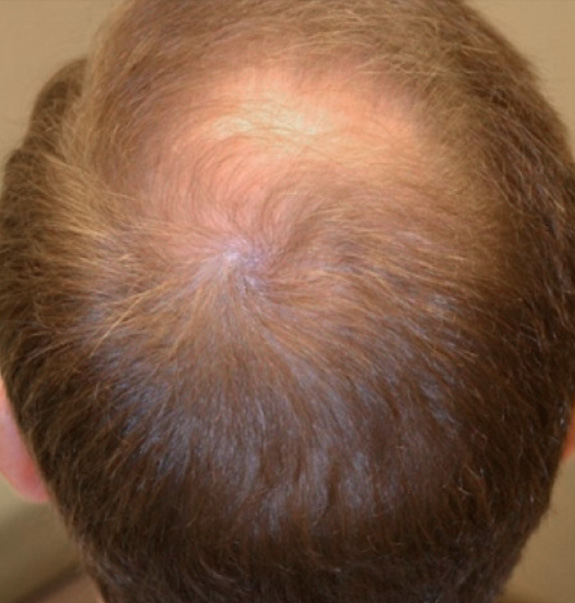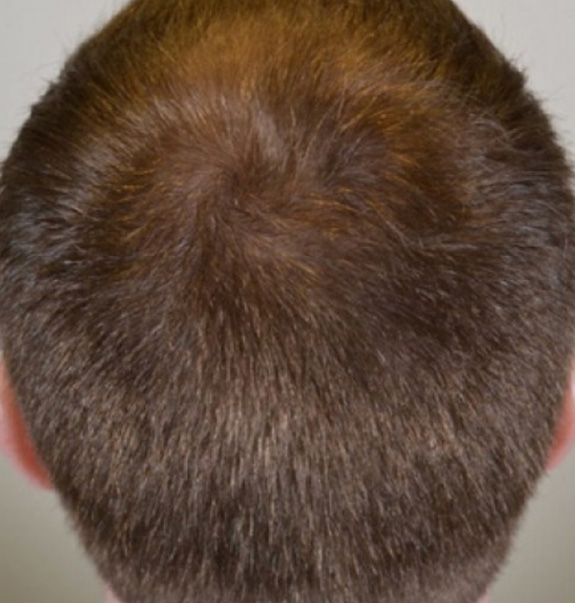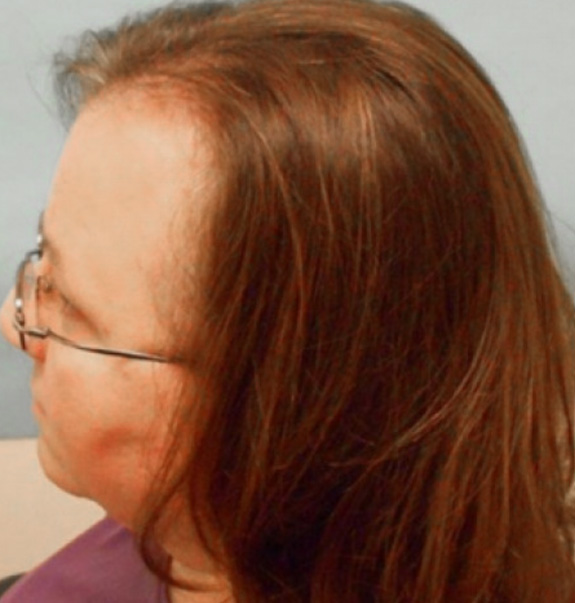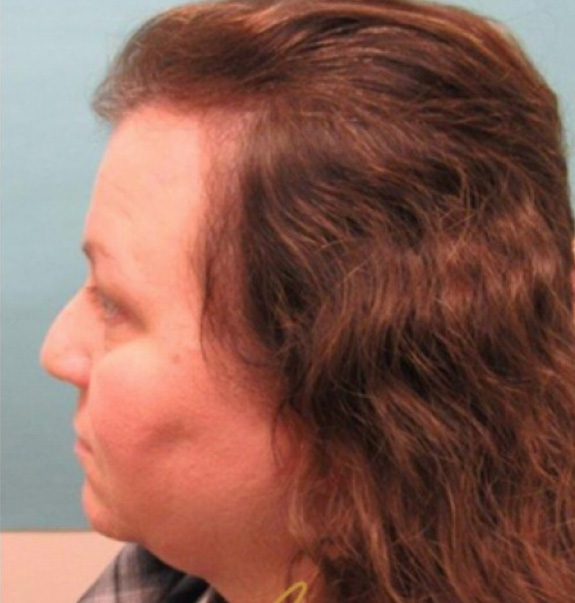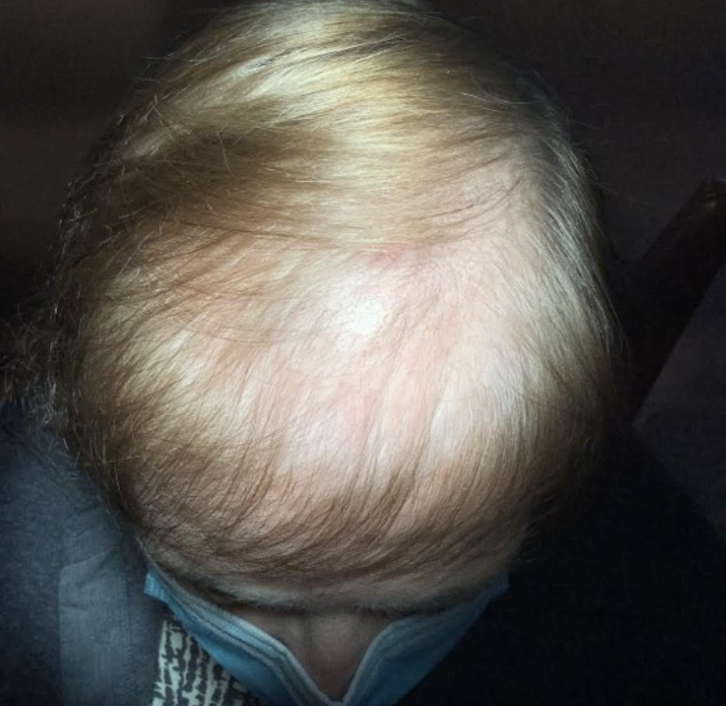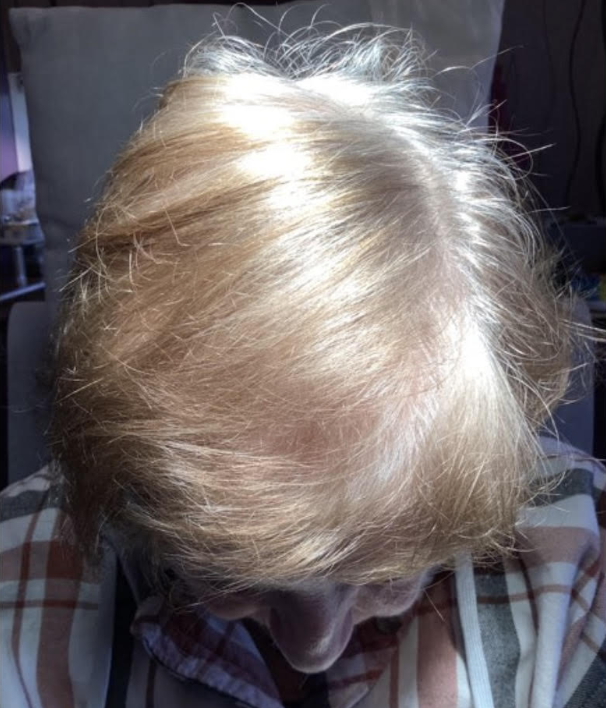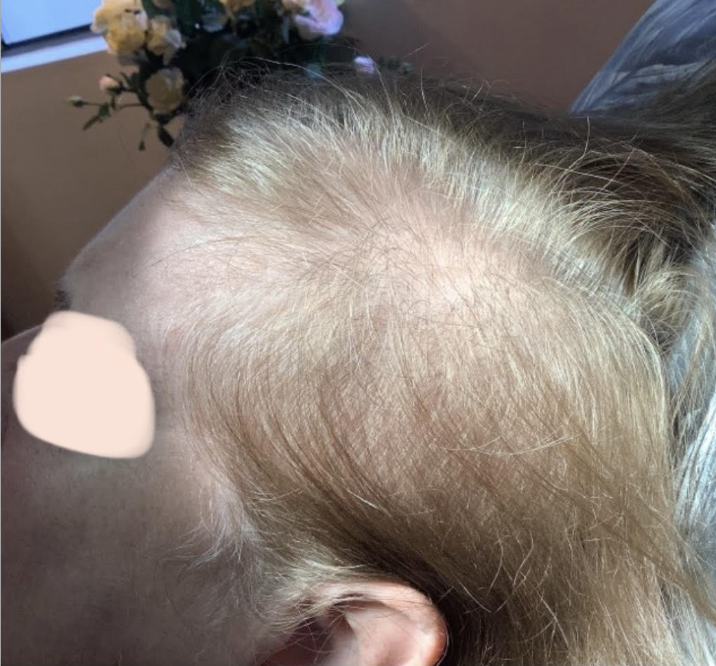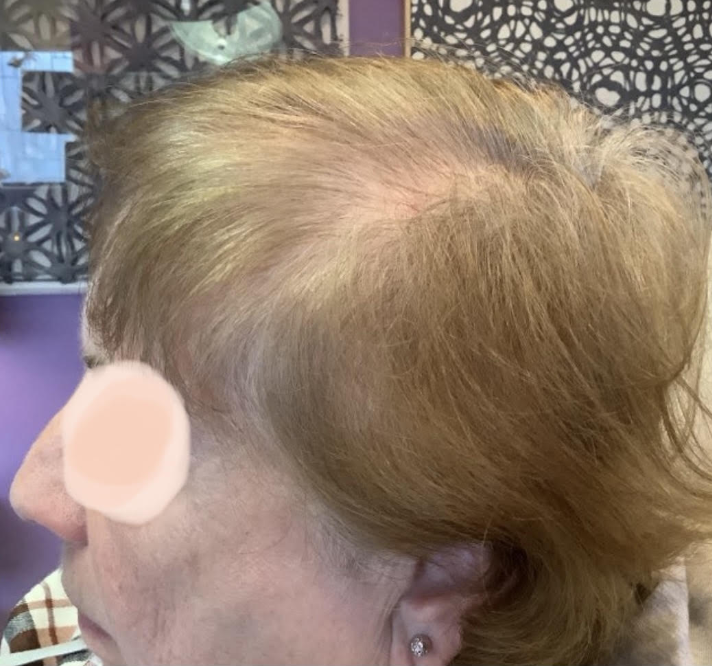Hair loss—also known as alopecia—can affect your scalp or your entire body. Hair loss is very common; alopecia causes 95% of cases of hair loss in men, and about 40% in women.
Men experience hair loss from genetics and hormonal imbalance, specifically of dihydrotestosterone (DHT). Men can also develop inflammatory conditions that cause hair loss that may affect the scalp, eyebrows, beard area, eyelashes and body. Aside from hereditary and hormonal influences, women are prone to developing certain inflammatory scalp conditions along the crown, sides and frontal scalp that can cause hair loss and affect regrowth.
Three common types of hair loss are as follows:
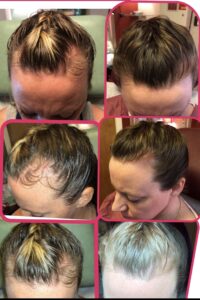
- Male/female pattern hair loss (androgenetic alopecia) — the most common cause of hair loss. Men often notice thinning at the top of the scalp and a receding hairline. Women notice the first sign of hair loss as a widening part.
- Alopecia areata – an autoimmune condition in which the body attacks its own hair follicles, resulting in smooth, round patches of hair loss. While it occurs most often on the scalp, it can affect the beard, eyebrows or eyelashes.
Telogen effluvium – while it’s normal to shed between 50 and 100 hairs a day, when the body sheds significantly more hairs every day, it’s considered excessive hair shedding, also known as telogen effluvium. Stress causes hair roots to be pushed prematurely into the resting state of the hair cycle, which can be observed with acute onset of handfuls of hair loss.
Different Forms of Hair Loss
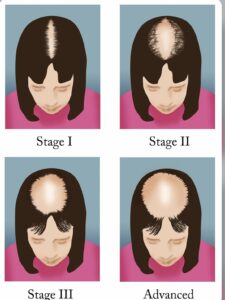 Hair loss, medically known as alopecia, occurs when the normal cycle of hair growth is disrupted. While hair loss can happen anywhere on the body, it most commonly affects the scalp. The scalp typically has around 100,000 hairs that go through cycles of growth, rest, shedding, and regeneration.
Hair loss, medically known as alopecia, occurs when the normal cycle of hair growth is disrupted. While hair loss can happen anywhere on the body, it most commonly affects the scalp. The scalp typically has around 100,000 hairs that go through cycles of growth, rest, shedding, and regeneration.
To understand hair loss, it’s important to know the three phases of the hair growth cycle. The anagen phase is when hair actively grows and can last for several years. The catagen phase is when hair stops growing and separates from the follicle, which is the structure that holds the hair in place beneath the skin. This phase lasts about 10 days. The telogen phase is a resting period for the follicle that lasts for two to three months before the hair falls out. The next anagen phase begins as a new hair grows in the same follicle. On average, people lose 50 to 100 hairs per day as part of this natural cycle.
However, if this cycle is disrupted or if the hair follicle is damaged, hair loss can occur more rapidly than it can be regenerated. This can lead to symptoms such as a receding hairline, patchy hair loss, or overall thinning.
Hair loss can be influenced by genetics, but there are also various medical and behavioral conditions that can interrupt the hair growth cycle and cause hair loss. At The Art of Skin Dermatology, our dermatologists specialize in hair and scalp disorders and can identify the type of hair loss and its underlying cause.
Androgenetic Alopecia
Androgenetic alopecia is the most common form of hair loss, affecting over 50 million men and 30 million women in the United States. It is commonly referred to as male pattern hair loss or female pattern hair loss. While it is hereditary, it can be managed with medication or surgery.
Male Pattern Hair Loss
In men, hair loss can begin after puberty and progress over the course of several years or even decades. It typically starts above the temples and continues around the perimeter and top of the head, often leaving a ring of hair along the bottom of the scalp. Many men with male pattern hair loss eventually become completely bald.
Female Pattern Hair Loss
In women, hair gradually thins all over the scalp, but the hairline usually remains intact. This type of hair loss is often seen as a natural part of aging, although it can begin after puberty. While female pattern hair loss can cause significant thinning, it rarely leads to complete baldness.
Telogen Effluvium
Telogen effluvium is a type of hair loss that occurs when a large number of follicles on the scalp enter the resting phase of the hair growth cycle (telogen), but the next growth phase doesn’t begin. This results in hair falling out all over the scalp without new hair growth. Telogen effluvium does not typically lead to complete baldness, but it can cause significant hair loss, with 300 to 500 hairs being shed per day. Hair may appear thin, especially at the crown and temples. This type of hair loss is often triggered by a medical event or condition, such as a thyroid imbalance, childbirth, surgery, or a fever. It can also be caused by a deficiency in vitamins or minerals, with iron deficiency being a common cause in women. Certain medications, such as isotretinoin for acne or warfarin as a blood thinner, can also lead to telogen effluvium. Starting or stopping oral contraceptives can also be a trigger. Telogen effluvium usually begins about three months after the triggering event. If the event is temporary, such as recovering from an illness or stopping medication, hair may regrow after about six months. However, if the hair loss persists for longer than six months, it is considered chronic. In such cases, our dermatologists can provide medication to help stimulate hair growth.
Anagen Effluvium
Anagen effluvium is rapid hair loss that occurs as a result of medical treatments like chemotherapy. These powerful medications kill cancer cells, but they can also halt hair follicle production in the scalp and other parts of the body. After chemotherapy ends, hair usually grows back on its own. Dermatologists can prescribe medication to expedite the regrowth process.
Alopecia Areata
Alopecia areata is an autoimmune condition where the body’s immune system attacks healthy tissues, including the hair follicles. This leads to hair loss and prevents new hair from growing. This condition can affect both adults and children, and hair loss can occur suddenly without warning. Hair typically falls out in small patches on the scalp, but it can also affect other areas like the eyebrows and eyelashes. Over time, it may progress to complete hair loss, known as alopecia totalis. Dermatologists can provide medication to help stimulate hair regrowth in individuals with alopecia areata.
Tinea Capitis
Tinea capitis, also known as scalp ringworm, is a fungal infection of the scalp that commonly causes hair loss in children. This condition leads to patchy hair loss, often in circular patterns, resulting in bald spots that may expand over time. Affected areas of the scalp may appear red or scaly, and itching may be present. Sores or blisters that ooze pus can also develop. Swollen glands in the neck or a low-grade fever may occur as the immune system fights the infection. Dermatologists can prescribe antifungal medication to be taken orally, which helps eliminate the fungus causing tinea capitis. Early diagnosis and treatment usually result in excellent hair regrowth in children.
Cicatricial Alopecia
Cicatricial alopecia, also known as scarring alopecia, is a rare form of hair loss characterized by inflammation that destroys hair follicles and leads to the formation of scar tissue. Once scar tissue forms, hair cannot regrow. Hair loss may occur gradually, making symptoms difficult to notice, or it may happen suddenly with significant hair loss. Other symptoms include severe itching, swelling, and the presence of red or white lesions on the scalp that resemble a rash. Cicatricial alopecia can affect individuals of any age and both men and women. Treatment for cicatricial alopecia depends on the specific type causing the symptoms. Our experienced doctors can recommend various treatments to help manage this condition. By understanding the various types of hair loss and their causes, our dermatologists at The Art of Skin Dermatology can provide the appropriate care and treatment to help individuals regain their hair and confidence. There are also various hair shaft abnormalities that can lead to hair loss. These conditions weaken the hair strands, making them prone to breaking. Treatment options depend on the specific abnormality.
Lichen Planopilaris
Lichen planopilaris is a form of alopecia that occurs when the scalp is affected by a common skin condition called lichen planus. This condition can cause the hair on the scalp to fall out in clumps, accompanied by a dry, flaky rash. The scalp may become red, irritated, and covered in small itchy bumps that can be either white or red. Lichen planopilaris is more prevalent in women than men and is not a common condition. Treatment for this condition usually involves medication to prevent further hair loss.
Discoid Lupus Erythematosus
Discoid lupus erythematosus is a type of autoimmune disease that affects the skin, resulting in inflamed sores and scarring on the ears, face, and scalp. Hair loss is a common symptom of this disease, as scar tissue forms on the scalp, preventing hair growth in affe
cted areas.
Folliculitis Decalvans
Folliculitis decalvans is an inflammatory disorder that destroys hair follicles, leading to hair loss. This condition is often accompanied by redness, swelling, and lesions on the scalp that may be itchy or contain pus. Unfortunately, this type of hair loss is irreversible, but dermatologists can provide medication to manage symptoms and potentially slow down the progression of hair loss.
Dissecting Cellulitis of the Scalp
Dissecting cellulitis of the scalp is a rare condition that causes the formation of pustules or lumps on the scalp. This condition can also lead to the development of scar tissue, which destroys hair follicles and causes hair loss. Medications can be prescribed to help control the symptoms of this condition.
Frontal Fibrosing AlopeciaFrontal fibrosing alopecia typically presents as a receding hairline pattern and can also result in hair loss in the eyebrows and underarms. This condition primarily affects postmenopausal women, and the cause is still unknown. Certain medications can be used to manage symptoms and potentially halt the progression of the disease.
Central Centrifugal Cicatricial AlopeciaCentral centrifugal cicatricial alopecia can occur due to the use of hair products or styling techniques that damage hair follicles. The frequent use of hair relaxers, blow dryers, curling irons, and hair extensions can lead to this condition, as well as the process of creating a permanent wave. Additionally, the excessive application of oils, gels, or pomades can also contribute to this condition. In some cases, stopping the use of these hair prod
ucts or styling techniques can reverse the condition. Medication may also be recommended by dermatologists to promote hair regrowth.
Hair Shaft Abnormalities
Various hair shaft abnormalities can result in hair loss. These conditions cause the hair strands to become thin and weak, making them prone to breakage. Unlike other types of hair loss, these abnormalities occur along the hair shaft rather than in the follicle. This can lead to overall thinning of the hair and the presence of many small, brittle hairs. Making simple changes to hair styling and treatment routines can help reverse some hair shaft abnormalities. However, certain conditions may require medical intervention. Some examples of hair shaft abnormalities include:
- Loose Anagen Syndrome
Loose anagen syndrome is most commonly observed in young children and occurs when hair is not firmly rooted in the follicle, making it easy to pull out. Hair often falls out after reaching a certain length, and children with this syndrome struggleto grow their hair beyond a relatively short length. The condition is more prevalent in girls with blond or brown hair. While there are limited treatment options, the condition tends to improve during puberty, and certain medications may promote fuller hair growth. - Trichotillomania
Trichotillomania is a condition where individuals have an irresistible urge to pull out their hair, resulting in hair loss on the scalp or other parts of the body. If the behavior is stopped, hair often regrows, but if the pulling continues for an extended period, hair loss can become permanent. Psychotherapy, including counseling to address underlying stressors and the urge to pull hair, is often the most effective treatment. Our doctors can provide referrals to psychotherapists specializing in this condition. - Traction Alopecia
Traction alopecia occurs when hairstyles such as tight ponytails and braids exert excessive force on the hair, leading to damage and hair loss. Unless the hairstyle is changed, traction alopecia can result in thinning hair or bald spots. Inmost cases, hair regrows once the hairstyle is altered. - Hypotrichosis
Hypotrichosis is a rare genetic condition characterized by minimal hair growth on the scalp and body. Babies born with this condition may initially have typical hair growth, but it falls out a few months later and is replaced with sparse hair. Many individuals with hypotrichosis experience baldness by the age of 25. Treatment options for this condition are limited, but certain medications may help thicken or regrow hair.
Hair loss can have a significant impact on a person’s self-esteem and quality of life. It is important to consult with a dermatologist to determine the type of hair loss and develop a personalized treatment plan.

